Impacts of Ridge-Furrow Planting on Salt Stress and Cotton Yield under Drip Irrigation
Abstract
:1. Introduction
2. Results
2.1. Temporal and Spatial Distribution of Soil Water and Electrical Conductivity of a Saturated Extract
2.1.1. Soil Water Content
2.1.2. Electrical Conductivity of the Saturated Soil Extract (ECe)
2.2. Plant Growth
2.2.1. Root-Length Density (RLD)
2.2.2. Aboveground Growth Indicators
2.3. Yield Components and Fiber Quality
3. Materials and Methods
3.1. Experimental Site Description
3.2. Experimental Design
3.3. Irrigation and Fertilization
3.4. Sampling and Measurements
3.4.1. Soil Water Content and ECe
3.4.2. Plant Growth
Root Length Density (RLD)
Aboveground Growth
Lint Yield and Fiber Quality
Statistical Analysis
4. Discussion
4.1. RF Increased Soil Water Content and Decreased ECe in the Root Zone
4.2. RF Promoted Cotton Growth and Improved Lint Yield
5. Conclusions
Acknowledgments
Author Contributions
Conflicts of Interest
References
- Ramos, T.B.; Šimůnek, J.; Gonçalves, M.C.; Martins, J.C.; Prazeres, A.; Castanheira, N.L.; Pereira, L.S. Field evaluation of a multicomponent solute transport model in soils irrigated with saline waters. J. Hydrol. 2011, 407, 129–144. [Google Scholar] [CrossRef]
- Sousa, J.W.; Baldwin, C.; Camkin, J.; Fidelman, P.; Silva, O.; Neto, S.; Smith, F.T. Water: Drought, Crisis and Governance in Australia and Brazil. Water 2016, 8, 493. [Google Scholar] [CrossRef]
- Ivits, E.; Cherlet, M.; Tóth, T.; Lewińska, K.E.; Tóth, G. Characterization of productivity limitation of salt-affected lands in different climate regions of Europe using remote sensing derived productivity indicators. Land Degrad. Dev. 2013, 24, 438–452. [Google Scholar]
- Li, Z.S.; Ou, Y.; Liu, X.Y.; Hu, C.S. Scientific Basis for Constructing the “Bohai Sea Granary”—Demands, Potential and Approaches. Bull. Chin. Acad. Sci. 2011, 26, 371–374. [Google Scholar]
- Wallender, W.W.; Tanji, K.K. Agricultural Salinity Assessment and Management; Manuals and Reports on Engineering Practice No. 71; American Society of Civil Engineers: Reston, VA, USA, 2011. [Google Scholar]
- Qadir, M.; Ghafoor, A.; Murtaza, G. Amelioration strategies for saline soils: A review. Land Degrad. Dev. 2000, 11, 501–521. [Google Scholar] [CrossRef]
- Pasternak, D. Salt Tolerance and Crop Production—A Comprehensive Approach. Annu. Rev. Phytopathol. 2003, 25, 271–291. [Google Scholar] [CrossRef]
- Mao, W.B.; Kang, S.; Wan, Y.; Sun, Y.; Li, X.; Wang, Y. Yellow river sediment as a soil amendment for amelioration of saline land in the Yellow river delta. Land Degrad. Dev. 2014, 27, 1595–1602. [Google Scholar] [CrossRef]
- Wang, X.B.; Zhao, Q.; Hu, Y.; Zheng, Y.; Wu, X.; Wu, H.; Zhang, G.; Cai, D.; Manzur, C.L. An alternative water source and combined agronomic practices for cotton irrigation in coastal saline soils. Irrig. Sci. 2012, 30, 221–232. [Google Scholar] [CrossRef]
- Ahmed, I.M.; Cao, F.; Zhang, M.; Chen, X.; Zhang, G.; Wu, F. Difference in yield and physiological features in response to drought and salinity combined stress during anthesis in Tibetan wild and cultivated barleys. PLoS ONE 2013, 8, e77869. [Google Scholar] [CrossRef] [PubMed]
- Devkota, M.; Martius, C.; Gupta, R.K.; Devkota, K.P.; Mcdonald, A.J.; Lamers, J.P.A. Managing soil salinity with permanent bed planting in irrigated production systems in Central Asia. Agric. Ecosyst. Environ. 2015, 202, 90–97. [Google Scholar] [CrossRef]
- Tian, Y.; Su, D.; Li, F.; Li, X. Effect of rainwater harvesting with ridge and furrow on yield of potato in semiarid areas. Field Crops Res. 2003, 84, 385–391. [Google Scholar] [CrossRef]
- Tisdall, J.M.; Hodgson, A.S. Ridge tillage in Australia: A review. Soil Tillage Res. 1990, 18, 127–144. [Google Scholar] [CrossRef]
- Zhao, Y.G.; Li, Y.; Wang, J.; Pang, H.; Li, Y. Buried straw layer plus plastic mulching reduces soil salinity and increases sunflower yield in saline soils. Soil Tillage Res. 2016, 155, 363–370. [Google Scholar] [CrossRef]
- Zhang, H.; Ma, P.; Zhao, Z.; Zhao, G.; Tian, B.; Wang, J.; Wang, G. Mapping QTL controlling maize deep-seeding tolerance-related traits and confirmation of a major QTL for mesocotyl length. Theor. Appl. Genet. 2012, 124, 223–232. [Google Scholar] [CrossRef] [PubMed]
- Knappenberger, T.; Köller, K. Spatial assessment of the correlation of seeding depth with emergence and yield of corn. Precis. Agric. 2012, 13, 163–180. [Google Scholar] [CrossRef]
- Loeppky, H.; Lafond, G.P.; Fowler, D.B. Seeding Depth in Relation to Plant Development, Winter Survival, and Yield of No-Till Winter Wheat. Agron. J. 1989, 81, 125–129. [Google Scholar] [CrossRef]
- Kato, F.; Araki, M.; Miyazawa, Y.; Fujii, N.; Takeda, K.; Suge, H.; Takahashi, H. Factors responsible for deep-sowing tolerance in wheat seedlings: Varietal differences in cell proliferation and the co-ordinated synchronization of epidermal cell expansion and cortical cell division for the gibberellin-mediated elongation of first. Ann. Bot. 2011, 108, 439–447. [Google Scholar] [CrossRef] [PubMed]
- Dong, H.Z. Underlying mechanisms and related techniques of stand establishment of cotton on coastal saline-alkali soil. Chin. J. Appl. Ecol. 2012, 23, 566–572. [Google Scholar]
- Wang, Z.B.; Li, C.; Liu, Y.; Liu, L.; Sun, H.; Zhang, Y. Effectiveness of the micro-ditch and overbite-membrane planting model for cotton in a dry and alkaline coastal area. Cotton Sci. 2012, 24, 318–324. [Google Scholar]
- Li, X.; Su, D.; Yuan, Q. Ridge-furrow planting of alfalfa (Medicago sativa L.) for improved rainwater harvest in rainfed semiarid areas in Northwest China. Soil Tillage Res. 2007, 93, 117–125. [Google Scholar] [CrossRef]
- Li, X.Y.; Gong, J.D.; Gao, Q.Z.; Li, F.R. Incorporation of ridge and furrow method of rainfall harvesting with mulching for crop production under semiarid conditions. Agric. Water Manag. 2001, 50, 173–183. [Google Scholar] [CrossRef]
- Devkota, M.; Gupta, R.K.; Martius, C.; Lamers, J.P.A.; Devkota, K.P.; Sayre, K.D.; Vlek, P.L.G. Soil salinity management on raised beds with different furrow irrigation modes in salt-affected lands. Agric. Water Manag. 2015, 152, 243–250. [Google Scholar] [CrossRef]
- Qadir, M.; Oster, J.D. Crop and irrigation management strategies for saline-sodic soils and waters aimed at environmentally sustainable agriculture. Sci. Total Environ. 2004, 323, 1–19. [Google Scholar] [CrossRef] [PubMed]
- Meiri, A.; Plaut, Z. Crop production and management under saline conditions. Plant Soil 1985, 89, 253–271. [Google Scholar] [CrossRef]
- Mass, E.V.; Hoffman, G.J. Crop salt tolerance: Current assessment. J. Irrig. Drain. Div. 1977, 103, 115–134. [Google Scholar]
- Fang, S.; Chen, X. Influence of atmospheric precipitation on soil leaching and desalinization in the North China Plain. Acta Pedol. Sin. 2005, 42, 730–736. [Google Scholar]
- Ma, B.L.; Text, A.T.F. Ridge-furrow with full plastic film mulching improves water use efficiency and tuber yield of potato in a semiarid rainfed ecosystem. Field Crops Res. 2014, 161, 137–148. [Google Scholar]
- Wang, Y.Z.; Yuan, X.J. Effects of plastic film mulching on temperature increase and preservation of soil moisture and its response s to growth character of rice with dry-land cultivation. Trans. Chin. Soc. Agric. Eng. 2002, 18, 29–31. [Google Scholar]
- Du, X.; Zhang, W.H.; Zhang, Y.S.; Cao, C.Y.; Li, K.J. Artificial warming from late winter to early spring by phased plastic mulching increases grain yield of winter wheat. Acta. Agron. Sin. 2016, 42, 1530–1540. [Google Scholar] [CrossRef]
- Dong, H.Z.; Li, W.; Miao, X. Ecological effects of mulched deep-seeding in relation to stand establishment and lint yield of cotton in saline soil. Cotton Sci. 2011, 23, 121–126. [Google Scholar]
- Jury, W.A.; Horton, R. Soil Physics; John Wiley & Sons: Hoboken, NJ, USA, 1991; Volume 21, p. 4. [Google Scholar]
- Yu, X.G.; Sun, J.; Xiao, J.; Liu, Z.; Zhang, J. A study on drought indices and lower limit of suitable soil moisture of cotton. Acta Gossypii Sin. 1999, 11, 35–38. [Google Scholar]
- Dong, H.; Kong, X.; Luo, Z.; Li, W.; Xin, C. Unequal salt distribution in the root zone increases growth and yield of cotton. Eur. J. Agron. 2010, 33, 285–292. [Google Scholar] [CrossRef]
- Wang, X.; Zhang, L.; Evers, J.B.; Mao, L.; Wei, S.; Pan, X.; Zhao, X.; Werf, W.V.D.; Li, Z. Predicting the effects of environment and management on cotton fibre growth and quality: A functional-structural plant modelling approach. AoB Plants 2014, 6, 301–307. [Google Scholar] [CrossRef] [PubMed]
- Hatfield, J.L.; Sauer, T.J.; Prueger, J.H. Managing Soils to Achieve Greater Water Use Efficiency. Agron. J. 2001, 93, 271–280. [Google Scholar] [CrossRef]
- Li, H.; Yi, J.; Zhang, J.; Zhao, Y.; Si, B.; Hill, R.L.; Cui, L.; Liu, X. Modeling of Soil Water and Salt Dynamics and Its Effects on Root Water Uptake in Heihe Arid Wetland, Gansu, China. Water 2015, 7, 2382–2401. [Google Scholar] [CrossRef]
- Zhang, X.; Chen, S.; Sun, H.; Pei, D.; Wang, Y. Dry matter, harvest index, grain yield and water use efficiency as affected by water supply in winter wheat. Irrig. Sci. 2008, 27, 1–10. [Google Scholar] [CrossRef]
- Harter, T.; Davis, H.; Mathews, M.C.; Meyer, R.D. Shallow groundwater quality on dairy farms with irrigated forage crops. J. Contam. Hydrol. 2002, 55, 287–315. [Google Scholar] [CrossRef]
- Abliz, A.; Tiyip, T.; Ghulam, A.; Ümüt, H.; Ding, J.L.; Sawut, M.; Zhang, F.; Nurmemet, I.; Abliz, A. Effects of shallow groundwater table and salinity on soil salt dynamics in the Keriya Oasis, Northwestern China. Environ. Earth Sci. 2016, 75, 1–15. [Google Scholar] [CrossRef]
- Isidoro, D.; Grattan, S.R. Predicting soil salinity in response to different irrigation practices, soil types and rainfall scenarios. Irrig. Sci. 2011, 29, 197–211. [Google Scholar] [CrossRef]
- Adcock, D.; Mcneill, A.M.; Mcdonald, G.K.; Armstrong, R.D. Subsoil constraints to crop production on neutral and alkaline soils in south-eastern Australia: A review of current knowledge and management strategies. Anim. Prod. Sci. 2007, 47, 1245–1261. [Google Scholar] [CrossRef]
- Scotter, D.R.; Raats, P.A.C. Movement of salt and water near crystalline salt in relatively dry soil. Soil Sci. 1970, 109, 170–178. [Google Scholar] [CrossRef]
- Chen, L.J.; Feng, Q.; Li, F.R.; Li, C.S. Simulation of soil water and salt transfer under mulched furrow irrigation with saline water. Geoderma 2014, 241–242, 87–96. [Google Scholar] [CrossRef]
- Mmolawa, K.; Or, D. Root zone solute dynamics under drip irrigation: A review. Plant Soil 2000, 222, 163–190. [Google Scholar] [CrossRef]
- Lipiec, J.; Kuś, J.; Słowińska-Jurkiewicz, A.; Nosalewicz, A. Soil porosity and water infiltration as influenced by tillage methods. Soil Tillage Res. 2006, 89, 210–220. [Google Scholar] [CrossRef]
- Guo, K.; Liu, X. Dynamics of meltwater quality and quantity during saline ice melting and its effects on the infiltration and desalinization of coastal saline soils. Agric. Water Manag. 2014, 139, 1–6. [Google Scholar]
- Min, W.; Guo, H.; Zhou, G.; Zhang, W.; Ma, L.; Ye, J.; Hou, Z. Root distribution and growth of cotton as affected by drip irrigation with saline water. Field Crops Res. 2014, 169, 1–10. [Google Scholar] [CrossRef]
- Dong, H.; Li, W.; Tang, W.; Zhang, D. Furrow Seeding with Plastic Mulching Increases Stand Establishment and Lint Yield of Cotton in a Saline Field. Agron. J. 2008, 100, 1640–1646. [Google Scholar] [CrossRef]
- Dong, H.; Li, W.; Tang, W.; Zhang, D. Early plastic mulching increases stand establishment and lint yield of cotton in saline fields. Field Crops Res. 2009, 111, 269–275. [Google Scholar] [CrossRef]
- Li, Y.; Shao, M.A. Spatial and temporal variation of soil temperature extremum under plastic mulch in Xinjiang. J. Appl. Ecol. 2004, 15, 2039–2044. [Google Scholar]
- Feng, D.; Zhang, J.; Sun, C.; Liu, X.; Dang, H.; Cao, C.; Zheng, C.; Sun, J.; Li, K. Effects of long-term irrigation with saline water on soil physical-chemical properties and activities of soil enzyme. J. Soil Water Conserv. 2014, 28, 171–176. [Google Scholar]
- Joshi, N.L. Seedling emergence and yield of pearlmillet on naturally crusted arid soils in relation to sowing and cultural methods. Soil Tillage Res. 1987, 10, 103–112. [Google Scholar] [CrossRef]
- Li, C.; Lei, J.; Zhao, Y.; Xu, X.; Li, S. Effect of saline water irrigation on soil development and plant growth in the Taklimakan Desert Highway shelterbelt. Soil Tillage Res. 2015, 146, 99–107. [Google Scholar] [CrossRef]
- Zhang, J.; Sun, J.; Duan, A.; Wang, J.; Shen, X.; Liu, X. Effects of different planting patterns on water use and yield performance of winter wheat in the Huang-Huai-Hai plain of China. Agric. Water Manag. 2007, 92, 41–47. [Google Scholar] [CrossRef]
- Kucharik, C.J.; Fayram, N.J.; Nicholas, C.K. A paired study of prairie carbon stocks, fluxes, and phenology: Comparing the world’s oldest prairie restoration with an adjacent remnant. Glob. Chang. Biol. 2006, 12, 122–139. [Google Scholar] [CrossRef]
- He, Z.J.; Luo, H.H.; Han, C.L.; Zhang, H.Z.; Zhang, W.F. Effect of source-sink regulator on yield and fiber quality of under-mulch-drip Irrigation cotton under the different soil moisture conditions. J. Shihezi Univ. (Natl. Sci.) 2007, 25, 397–403. [Google Scholar]
- Bange, M.P.; Constable, G.A.; Gordon, S.G.; Naylor, G.R.S.; van der Sluijs, M.H.J. FIBREpak A Guide to Improving Australian Cotton Fibre Quality; CSIRO and the Cotton Catchment Communities Cooperative Research Centre, Cotton Catchment Communities (CRC): Narrabri, Australia, 2009; pp. 45–47. [Google Scholar]
- Ashraf, M. Salt Tolerance of Cotton: Some New Advances. Crit. Rev. Plant Sci. 2002, 21, 1–30. [Google Scholar] [CrossRef]
- Bernstein, L.; Bernstein, L. Salt Tolerance of Field Crops; United States Salinity Report to Collaborators: Riverside, CA, USA, 1960; pp. 37–38. [Google Scholar]
- Razzouk, S.; Whittington, W.J. Effects of salinity on cotton yield and quality. Field Crops Res. 1991, 26, 305–314. [Google Scholar] [CrossRef]
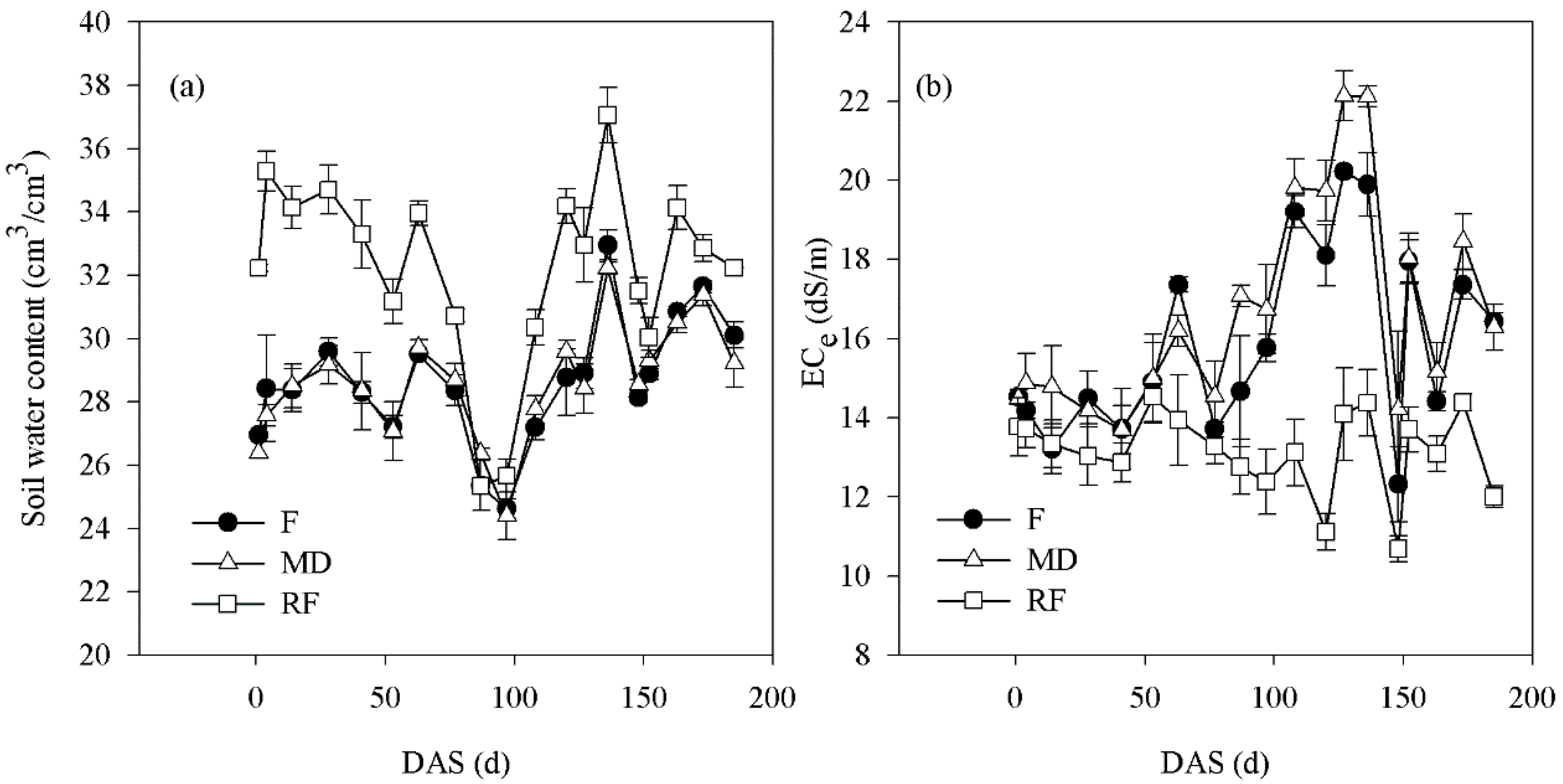
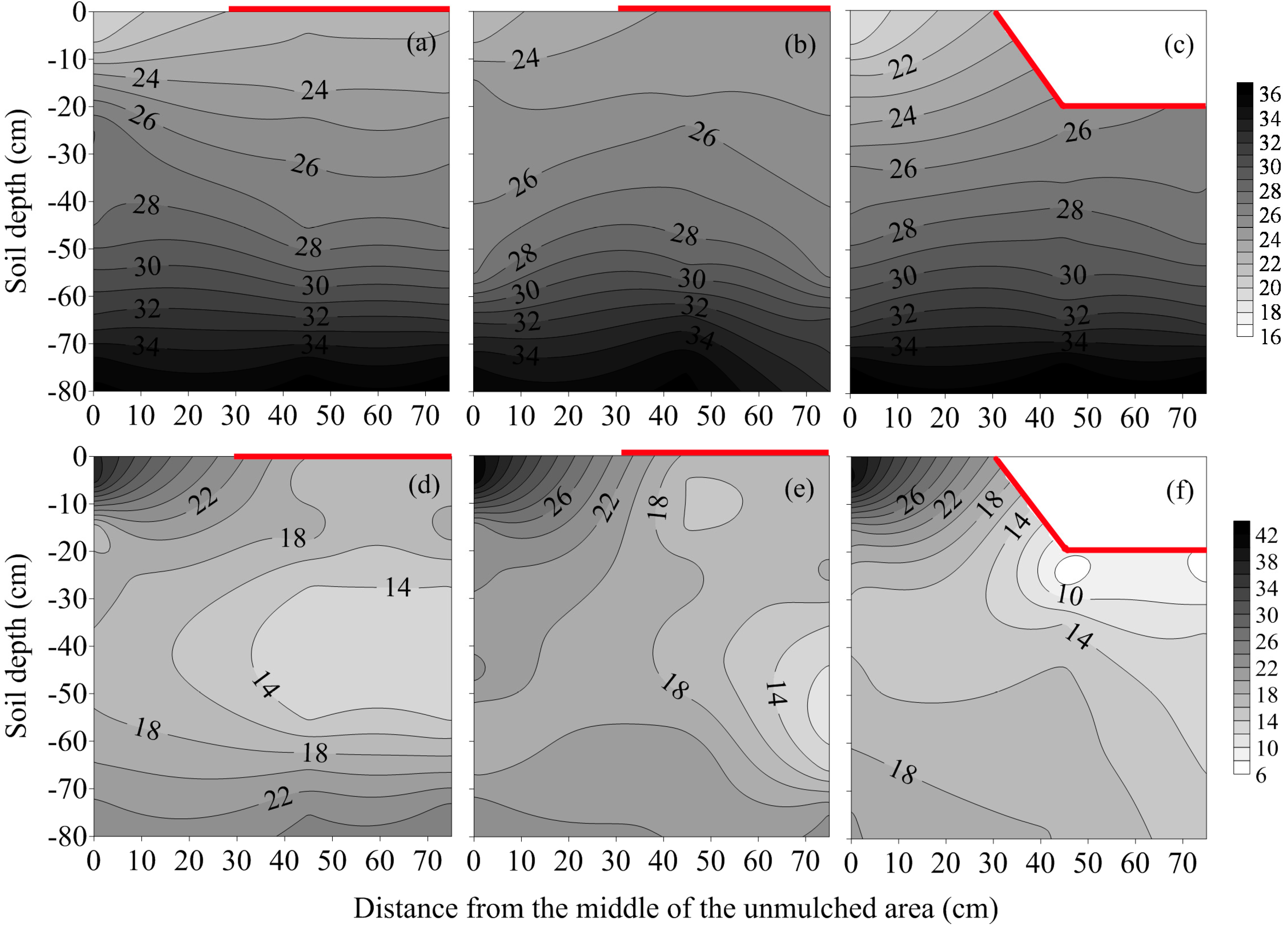
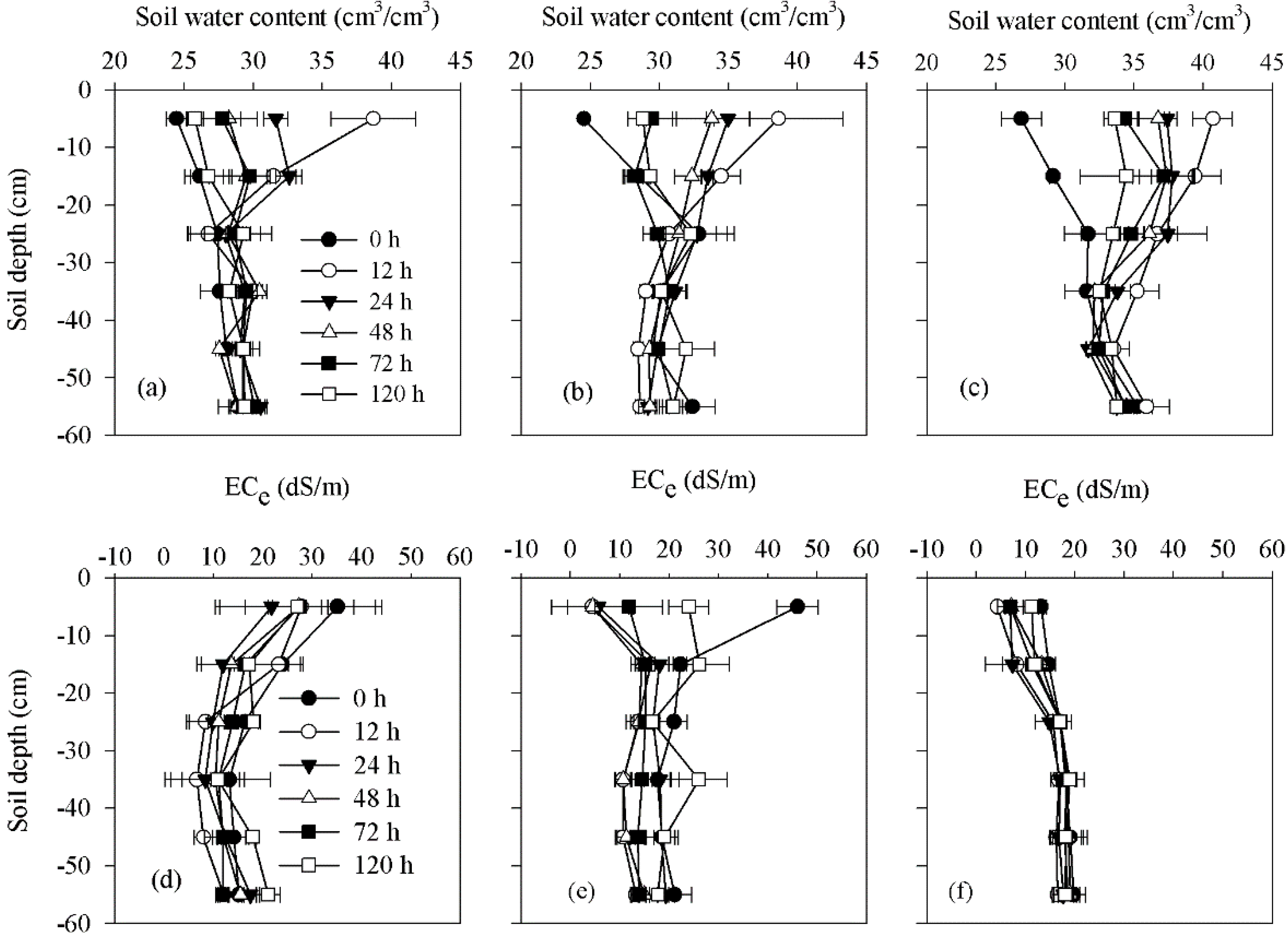
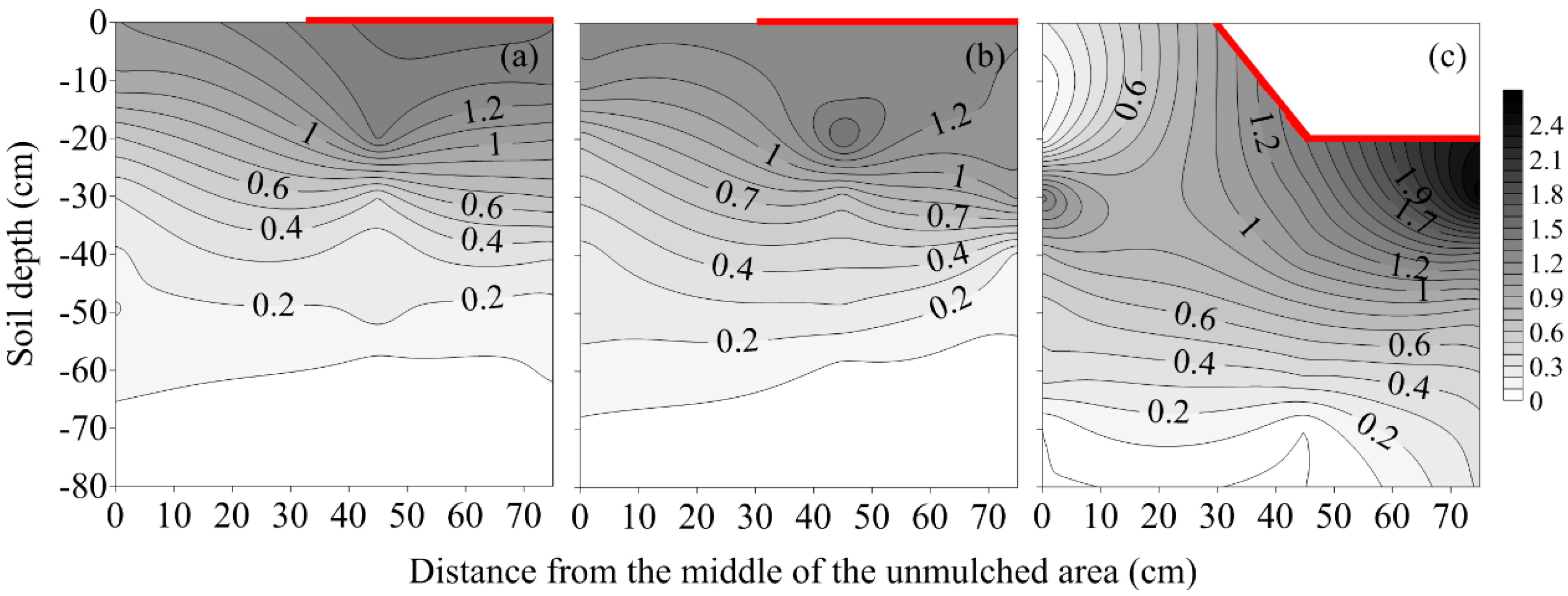
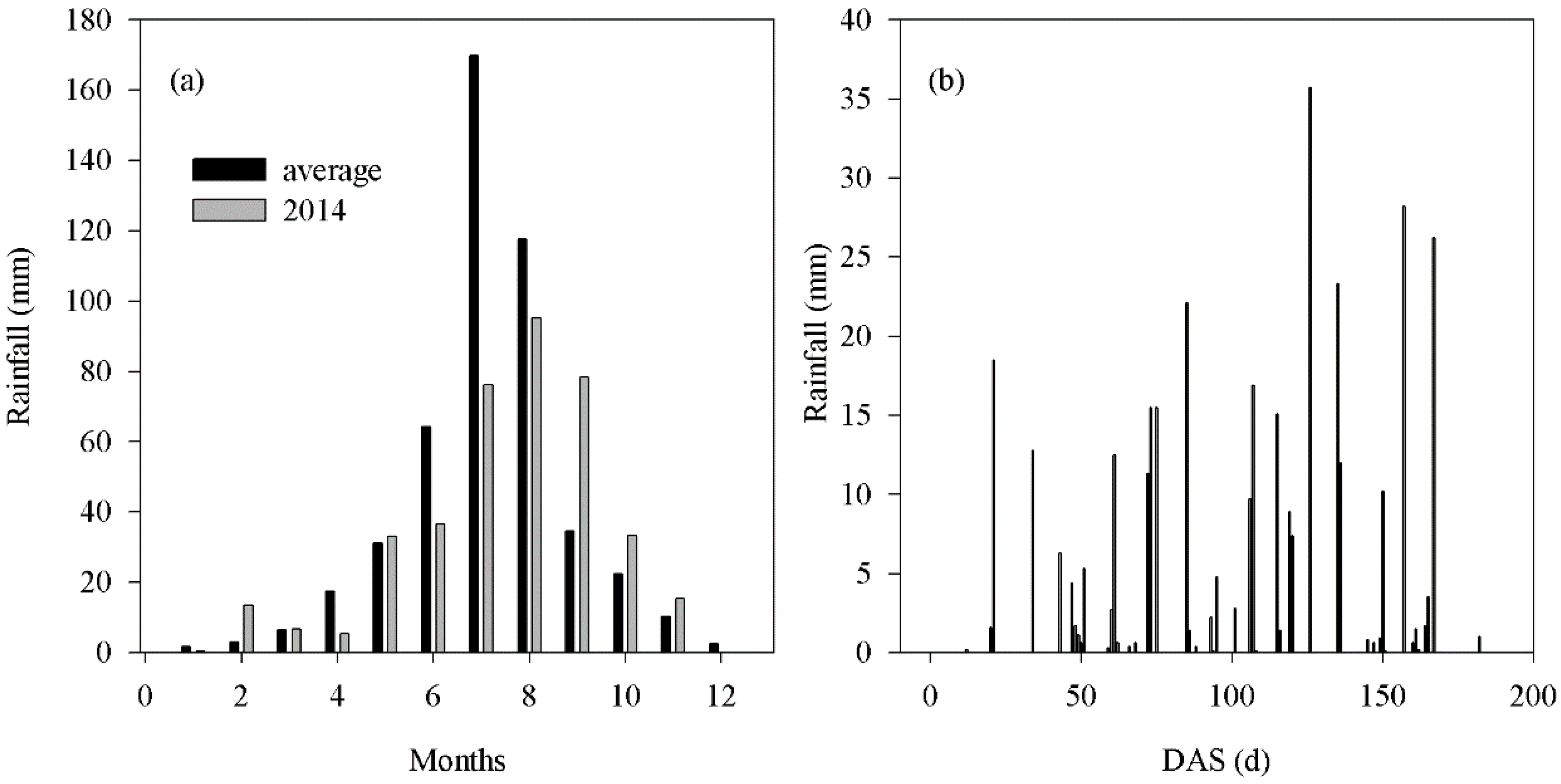
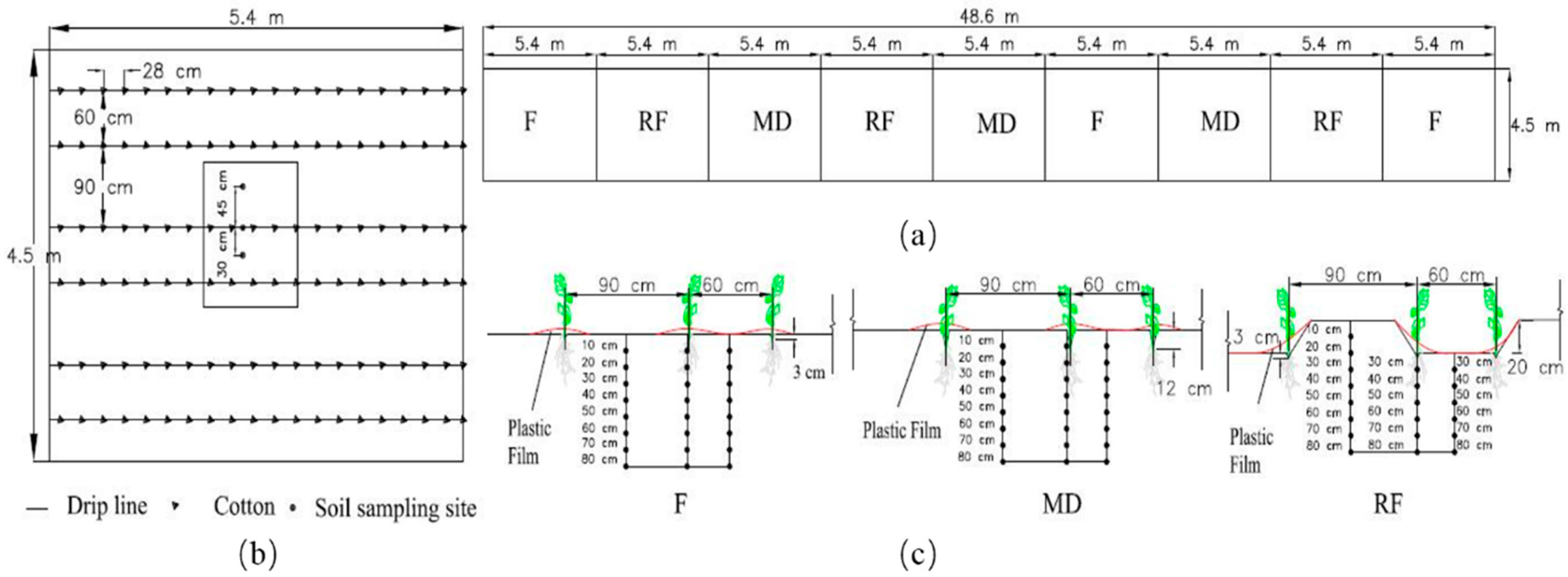
| Variables | Source | Df | F-Value | p-Value |
|---|---|---|---|---|
| Soil water content | Treatment | 2 | 39.220 | <0.001 |
| Time | 18 | 6.364 | <0.001 | |
| Treatment × time | 36 | 0.655 | 0.927 | |
| ECe | Treatment | 2 | 82.498 | <0.001 |
| Time | 18 | 11.792 | <0.001 | |
| Treatment × time | 36 | 2.738 | <0.001 |
| Time | Growth Indicators | F | MD | RF |
|---|---|---|---|---|
| 36 DAS (seedling stage) | Stand establishment rate (%) | 71.2 ± 10.8 c | 80.3 ± 9.6 a | 76.8 ± 12.1 b |
| Plant height (cm) | 8.9 ± 0.7 c | 10.8 ± 0.5 b | 12.4 ± 0.6 a | |
| Leaf area (cm2) | 49.8 ± 6.1 c | 66.1 ± 2.5 b | 97.3 ± 9.3 a | |
| Aboveground biomass per plant (g) | 0.81 ± 0.1 b | 1.01 ± 0.0 ab | 1.16 ± 0.12 a | |
| 126 DAS (boll-setting stage) | Plant height (cm) | 33.1 ± 3.5 b | 35.7 ± 4.2 b | 69.4 ± 4.1 a |
| Fruiting branches per plant | 5.2 ± 0.7 b | 5.9 ± 0.7 a | 6.4 ± 0.8 a | |
| Leaf area per plant (cm2) | 375.3 ± 84 b | 474.3 ± 46 b | 1185.2 ± 75 a | |
| Aboveground biomass per plant (g) | 19.7 ± 2.3 b | 22.9 ± 3.4 b | 56.2 ± 4.5 a |
| Components | Indicators | F | MD | RF |
|---|---|---|---|---|
| Lint components | Lint yield (kg/ha) | 493.9 ± 99.1 b | 617.0 ± 89.1 b | 927.9 ± 65.4 a |
| Lint percentage (%) | 41.8 ± 0.6 a | 41.9 ± 0.2 a | 42.1 ± 0.3 a | |
| Boll weight (g) | 5.67 ± 0.34 a | 5.65 ± 0.52 a | 5.71 ± 0.31 a | |
| Number of bolls per plant | 5.7 ± 0.4 b | 6.2 ± 0.2 b | 10.3 ± 0.2 a | |
| Fiber quality | Fiber length (mm) | 26.2 ± 1.0 a | 26.0 ± 1.2 a | 26.1 ± 0.7 a |
| Fiber length uniformity (%) | 81.1 ± 0.4 a | 81.2 ± 0.5 a | 81.6 ± 0.5 a | |
| Fiber micronaire | 5.8 ± 0.2 a | 5.8 ± 0.1 a | 5.9 ± 0.1 a | |
| Fiber strength (cN/tex) | 27.0 ± 1.4 a | 27.0 ± 1.1 a | 27.4 ± 0.4 a |
| Soil Depth (cm) | Soil Mechanical Composition | Bulk Density (g/cm3) | Field Capacity (cm3/cm3) | ECe (dS/m) | pH | ||
|---|---|---|---|---|---|---|---|
| Sand | Silt | Clay | |||||
| 0–20 | 35.04 | 54.31 | 10.65 | 1.67 | 38.0 | 20.20 | 7.56 |
| 20–40 | 25.56 | 49.45 | 25.00 | 1.67 | 38.0 | 22.61 | 7.56 |
| 40–60 | 29.38 | 48.19 | 22.43 | 1.59 | 37.8 | 19.34 | 7.60 |
| 60–80 | 25.38 | 50.77 | 23.85 | 1.59 | 37.8 | 21.60 | 7.55 |
| 80–100 | 30.94 | 54.54 | 14.51 | 1.51 | 38.1 | 24.43 | 7.48 |
© 2017 by the authors; licensee MDPI, Basel, Switzerland. This article is an open access article distributed under the terms and conditions of the Creative Commons Attribution (CC-BY) license (http://creativecommons.org/licenses/by/4.0/).
Share and Cite
Sun, C.; Feng, D.; Mi, Z.; Li, C.; Zhang, J.; Gao, Y.; Sun, J. Impacts of Ridge-Furrow Planting on Salt Stress and Cotton Yield under Drip Irrigation. Water 2017, 9, 49. https://doi.org/10.3390/w9010049
Sun C, Feng D, Mi Z, Li C, Zhang J, Gao Y, Sun J. Impacts of Ridge-Furrow Planting on Salt Stress and Cotton Yield under Drip Irrigation. Water. 2017; 9(1):49. https://doi.org/10.3390/w9010049
Chicago/Turabian StyleSun, Chitao, Di Feng, Zhaorong Mi, Caixia Li, Junpeng Zhang, Yang Gao, and Jingsheng Sun. 2017. "Impacts of Ridge-Furrow Planting on Salt Stress and Cotton Yield under Drip Irrigation" Water 9, no. 1: 49. https://doi.org/10.3390/w9010049
APA StyleSun, C., Feng, D., Mi, Z., Li, C., Zhang, J., Gao, Y., & Sun, J. (2017). Impacts of Ridge-Furrow Planting on Salt Stress and Cotton Yield under Drip Irrigation. Water, 9(1), 49. https://doi.org/10.3390/w9010049






